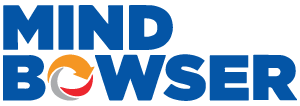Non-emergency medical transportation (NEMT) ensures patients without reliable transportation can still access essential care. Unlike a 911 ambulance, NEMT provides safe rides without emergency equipment or on-board clinical staff. Medicaid primarily funds it, though seniors, people with disabilities, and facilities also rely on it. With millions of rides provided each year, NEMT has become a lifeline for patients managing dialysis, chemotherapy, rehabilitation, and other routine care needs.
NEMT is straightforward in concept: it’s a medical ride service for patients who need help reaching care but don’t require emergency-level intervention. In other words, it’s the bridge between independence and the ER.
Unlike ambulances built for acute crises with paramedics and equipment, NEMT focuses on recurring, scheduled appointments. Think dialysis, chemotherapy, rehab therapy, or specialist visits. Medicaid requires every state to provide this benefit for eligible members, which is why NEMT has become one of the most widely used supports in American healthcare.
Bottom line: NEMT may not involve flashing lights, but it keeps patients out of hospitals by keeping them in care.
NEMT exists to address a fundamental yet often overlooked issue: transportation. Without it, vulnerable patients skip appointments, conditions worsen, and preventable admissions rise. Four main groups rely on this service.
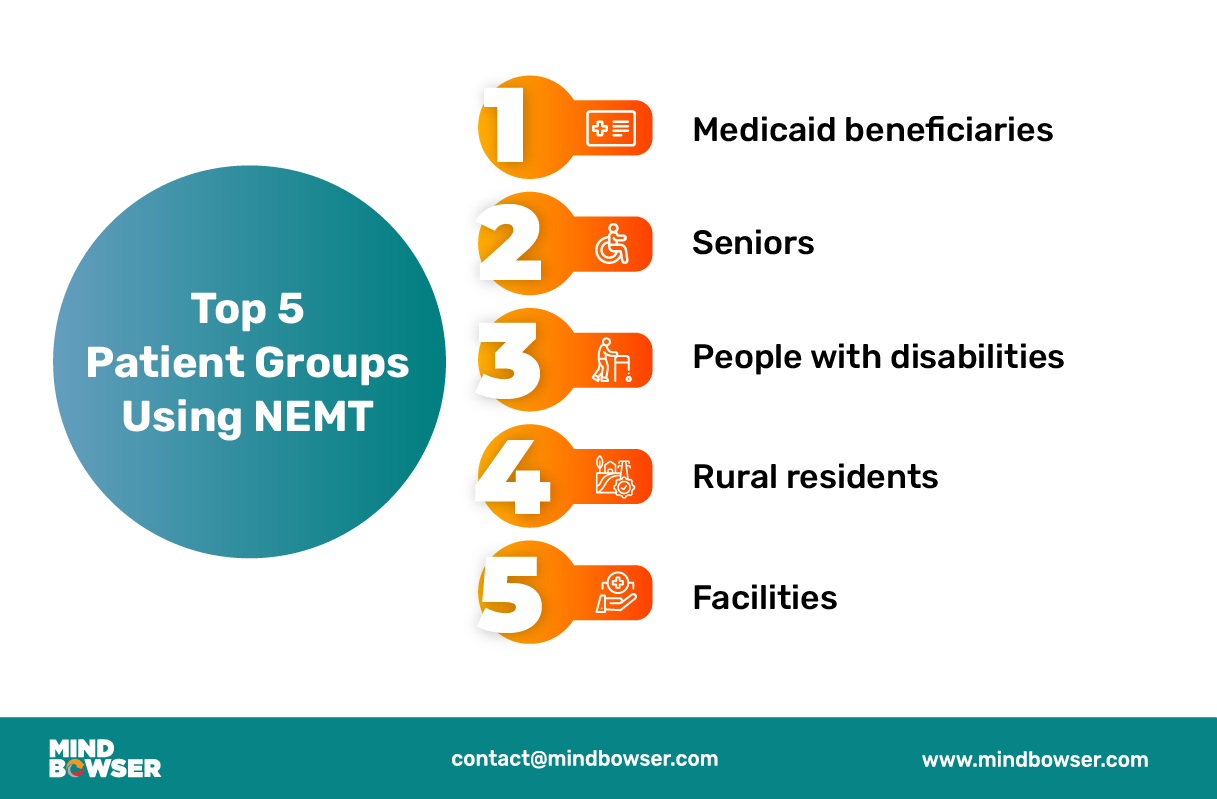
Consider Maria, 62, with chronic kidney disease. She needs dialysis three times a week. Public buses in her area are unreliable, and her family can’t always take time off work. Without NEMT, Maria would miss sessions, face fluid buildup, and risk hospitalization. With NEMT, she stays stable at home. Stories like hers are repeated across the country.
Net result: whether you’re Medicaid-eligible, aging in place, living in a rural area, or running a dialysis center, NEMT is the invisible infrastructure that keeps care on track.
NEMT doesn’t handle emergencies. Instead, it covers the recurring, medically necessary trips that keep patients connected to essential care. Coverage varies by patient eligibility, state Medicaid rules, and the type of appointment. The intent is always the same: prevent missed treatments that lead to costly complications.
Bottom line: These rides aren’t dramatic, but missing them can be.
NEMT isn’t one-size-fits-all. The right vehicle depends on the patient’s mobility and clinical needs.
Not every patient needs the same type of support. Medicaid and facility contracts often define two tiers:
Net result: NEMT is less about “rides” and more about sustaining health outcomes.
From the outside, NEMT looks simple: a patient books a ride, and a driver shows up. But behind that simplicity is a structured workflow designed to keep patients safe, providers reimbursed, and state Medicaid programs audit-ready.
Bottom line: what feels like “just a ride” to the patient is, in reality, a tightly regulated process.
Most states use a broker system to manage Medicaid NEMT. These organizations sit between the state, the provider, and the patient.
Each ride follows a predictable lifecycle—though every step carries compliance risk if done poorly.
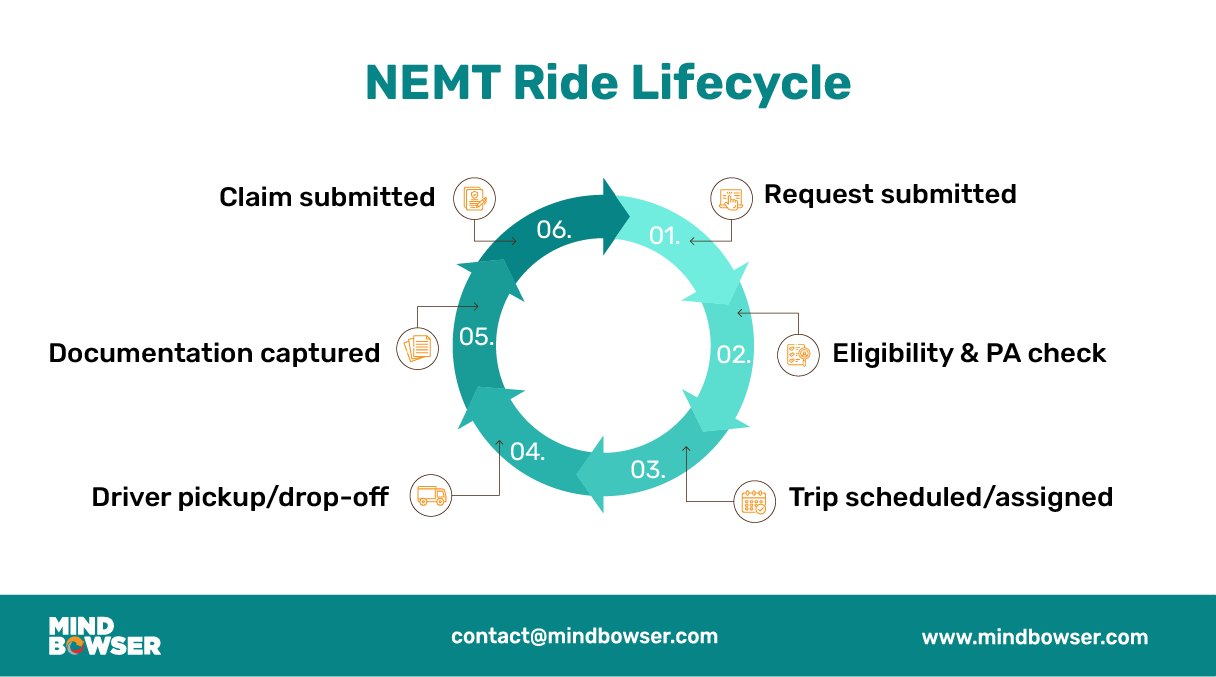
For Medicaid, documentation isn’t optional—it’s the foundation of payment and compliance.
Net result: incomplete documentation is the #1 reason providers face claim denials.
Modern NEMT platforms automate what used to be a manual, paper-intensive process.
At Mindbowser, we’ve seen providers significantly reduce denials by digitizing eligibility checks and trip verification. What used to take hours of paper log reconciliation now occurs in real-time with electronic capture. Staff are freed up, claims flow more efficiently, and patients receive a more reliable service.
NEMT is recognized as essential, but funding varies depending on the type of payer. Medicaid remains the largest backer, with private contracts and some insurance programs filling the gaps. For providers, understanding who pays is crucial because unclear reimbursement pathways can quickly result in denials or unpaid rides.
Bottom line: Know your payer mix before rolling out a service, or risk losing revenue.
Net result: funding is not just a back-office issue. It is the make-or-break factor for both patient access and provider survival.
NEMT is more than a ride service. Because it involves Medicaid reimbursement and patient health information, providers must adhere to strict compliance standards. Slip once, and the consequences can include denied claims, penalties, or lost contracts.
Bottom line: compliance is not optional. It is the foundation of revenue protection and patient trust.
Net result: Compliance is not just red tape. It is what keeps the business running and contracts intact.
NEMT is a lifeline for patients, but providers often face operational and financial roadblocks that limit quality and profitability. Most challenges stem from outdated processes or systems that cannot keep up with Medicaid’s requirements.
Bottom line: inefficiencies translate directly into revenue loss, staff burnout, and patient frustration.
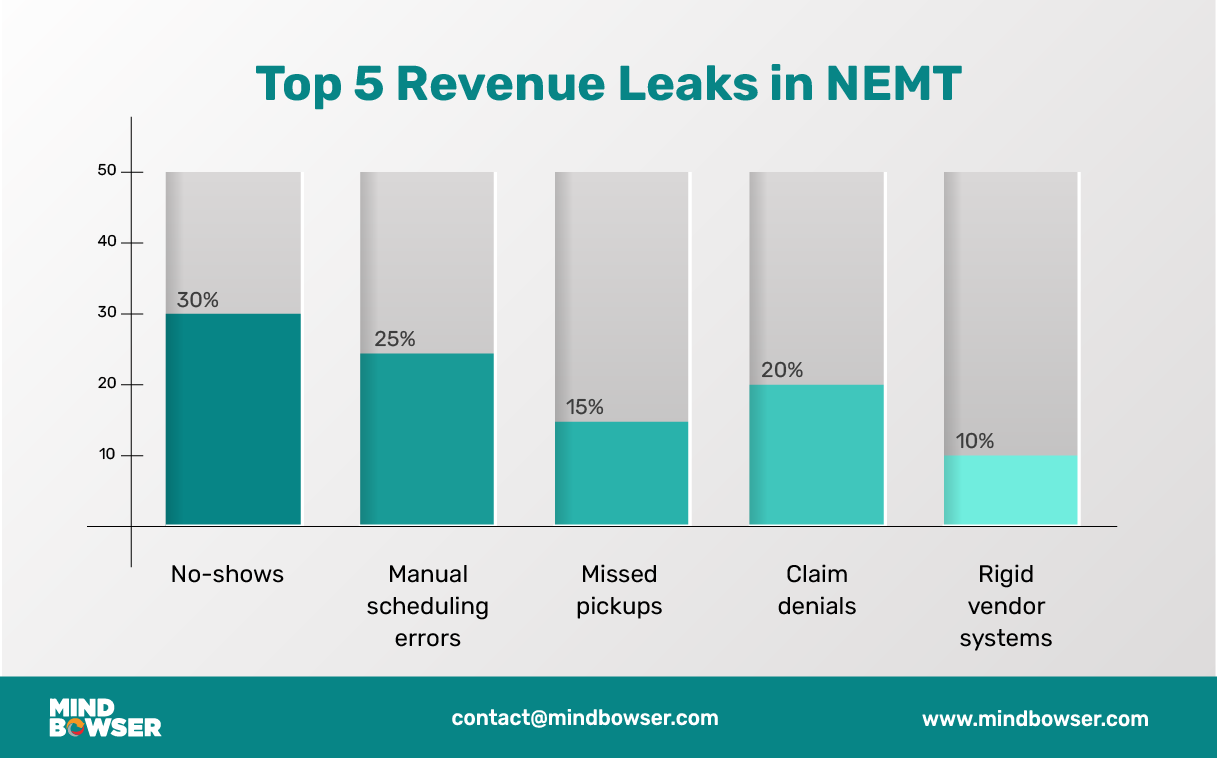
Net result: Operational cracks become financial losses and reputational risks.
Running NEMT with phone calls, spreadsheets, and paper logs is no longer a sustainable approach. The complexity of scheduling, compliance, and billing requires technology that centralizes workflows and reduces errors. Modern NEMT software does more than simplify operations. It protects revenue, improves patient satisfaction, and allows providers to grow with confidence.
Bottom line: technology is no longer optional in NEMT. It is the difference between surviving and scaling.

Mindbowser has built healthcare-focused solution accelerators that align with the most common NEMT challenges:
Providers who adopt these accelerators not only meet compliance requirements but also gain an edge in patient satisfaction and revenue protection.
Choosing the right software model is one of the most important decisions for NEMT providers. Both off-the-shelf and custom platforms bring value, but they serve different stages of growth. The wrong choice can stall expansion, erode margins, or leave providers with compliance gaps.
Bottom line: the right platform balances today’s needs with tomorrow’s growth plan.
Net result: software decisions are not just IT choices. They are strategic growth decisions.
For hospitals, dialysis centers, and NEMT operators, transportation workflows must be reliable before scaling. A simple checklist helps reduce errors, strengthen compliance, and build trust with patients. Each step below is a foundation for long-term sustainability.
Bottom line: get these basics right, and you are already ahead of the curve.
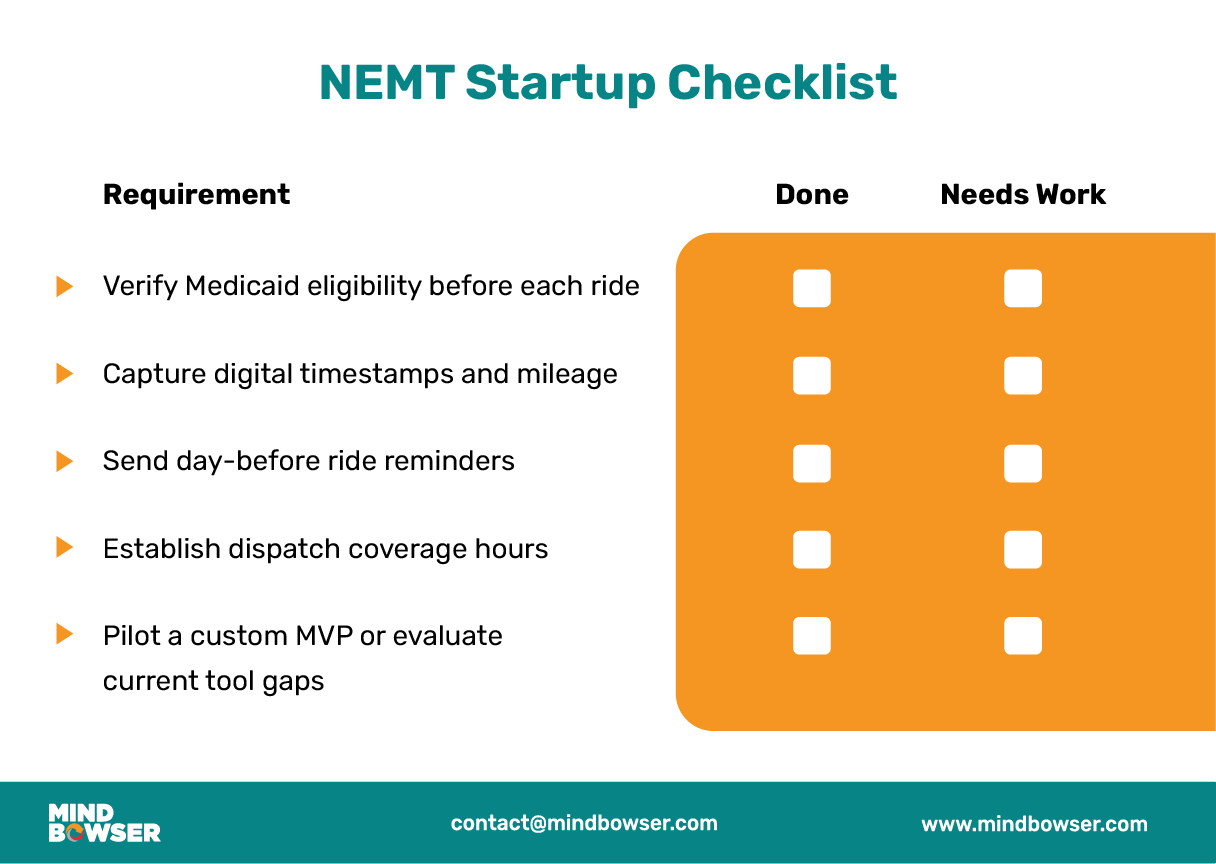
NEMT terminology can feel technical, especially for facilities or providers new to the space. This glossary translates the most common terms into plain language.
Bottom line: knowing the vocabulary keeps teams aligned and audits cleaner.

Non-emergency medical transportation (NEMT) may not draw headlines, but it plays a critical role in U.S. healthcare. It connects patients who cannot drive themselves with the care they need, preventing missed treatments and unnecessary hospitalizations. For providers, NEMT is both a business opportunity and a compliance responsibility.
Bottom line: NEMT keeps patients healthier and providers sustainable when managed correctly.
NEMT is often invisible until it fails. Patients miss care, providers lose revenue, and states absorb higher costs. But when it works well, everyone wins: patients stay healthier, hospitals avoid preventable admissions, and providers grow with confidence.
Net result: NEMT is more than transportation. It is healthcare infrastructure in motion.
No. An ambulance provides emergency-level transport with paramedics and clinical equipment.NEMT provides safe and reliable rides for patients who do not require emergency intervention.The focus of NEMT is recurring, scheduled appointments such as dialysis or therapy.
Eligibility is determined by each state’s Medicaid rules. Generally, patients qualify if they have no other reliable means of reaching medically necessary appointments. States often require eligibility verification and, in some cases, prior authorization before a ride is approved.

We worked with Mindbowser on a design sprint, and their team did an awesome job. They really helped us shape the look and feel of our web app and gave us a clean, thoughtful design that our build team could...


The team at Mindbowser was highly professional, patient, and collaborative throughout our engagement. They struck the right balance between offering guidance and taking direction, which made the development process smooth. Although our project wasn’t related to healthcare, we clearly benefited...

Founder, Texas Ranch Security

Mindbowser played a crucial role in helping us bring everything together into a unified, cohesive product. Their commitment to industry-standard coding practices made an enormous difference, allowing developers to seamlessly transition in and out of the project without any confusion....

CEO, MarketsAI

I'm thrilled to be partnering with Mindbowser on our journey with TravelRite. The collaboration has been exceptional, and I’m truly grateful for the dedication and expertise the team has brought to the development process. Their commitment to our mission is...

Founder & CEO, TravelRite

The Mindbowser team's professionalism consistently impressed me. Their commitment to quality shone through in every aspect of the project. They truly went the extra mile, ensuring they understood our needs perfectly and were always willing to invest the time to...

CTO, New Day Therapeutics

I collaborated with Mindbowser for several years on a complex SaaS platform project. They took over a partially completed project and successfully transformed it into a fully functional and robust platform. Throughout the entire process, the quality of their work...

President, E.B. Carlson

Mindbowser and team are professional, talented and very responsive. They got us through a challenging situation with our IOT product successfully. They will be our go to dev team going forward.

Founder, Cascada

Amazing team to work with. Very responsive and very skilled in both front and backend engineering. Looking forward to our next project together.

Co-Founder, Emerge

The team is great to work with. Very professional, on task, and efficient.

Founder, PeriopMD

I can not express enough how pleased we are with the whole team. From the first call and meeting, they took our vision and ran with it. Communication was easy and everyone was flexible to our schedule. I’m excited to...

Founder, Seeke

We had very close go live timeline and Mindbowser team got us live a month before.

CEO, BuyNow WorldWide

Mindbowser brought in a team of skilled developers who were easy to work with and deeply committed to the project. If you're looking for reliable, high-quality development support, I’d absolutely recommend them.

Founder, Teach Reach

Mindbowser built both iOS and Android apps for Mindworks, that have stood the test of time. 5 years later they still function quite beautifully. Their team always met their objectives and I'm very happy with the end result. Thank you!

Founder, Mindworks

Mindbowser has delivered a much better quality product than our previous tech vendors. Our product is stable and passed Well Architected Framework Review from AWS.

CEO, PurpleAnt

I am happy to share that we got USD 10k in cloud credits courtesy of our friends at Mindbowser. Thank you Pravin and Ayush, this means a lot to us.

CTO, Shortlist

Mindbowser is one of the reasons that our app is successful. These guys have been a great team.

Founder & CEO, MangoMirror

Kudos for all your hard work and diligence on the Telehealth platform project. You made it possible.

CEO, ThriveHealth

Mindbowser helped us build an awesome iOS app to bring balance to people’s lives.

CEO, SMILINGMIND

They were a very responsive team! Extremely easy to communicate and work with!

Founder & CEO, TotTech

We’ve had very little-to-no hiccups at all—it’s been a really pleasurable experience.

Co-Founder, TEAM8s

Mindbowser was very helpful with explaining the development process and started quickly on the project.

Executive Director of Product Development, Innovation Lab

The greatest benefit we got from Mindbowser is the expertise. Their team has developed apps in all different industries with all types of social proofs.

Co-Founder, Vesica

Mindbowser is professional, efficient and thorough.

Consultant, XPRIZE

Very committed, they create beautiful apps and are very benevolent. They have brilliant Ideas.

Founder, S.T.A.R.S of Wellness

Mindbowser was great; they listened to us a lot and helped us hone in on the actual idea of the app. They had put together fantastic wireframes for us.

Co-Founder, Flat Earth

Mindbowser was incredibly responsive and understood exactly what I needed. They matched me with the perfect team member who not only grasped my vision but executed it flawlessly. The entire experience felt collaborative, efficient, and truly aligned with my goals.

Founder, Child Life On Call

The team from Mindbowser stayed on task, asked the right questions, and completed the required tasks in a timely fashion! Strong work team!

CEO, SDOH2Health LLC

Mindbowser was easy to work with and hit the ground running, immediately feeling like part of our team.

CEO, Stealth Startup

Mindbowser was an excellent partner in developing my fitness app. They were patient, attentive, & understood my business needs. The end product exceeded my expectations. Thrilled to share it globally.

Owner, Phalanx

Mindbowser's expertise in tech, process & mobile development made them our choice for our app. The team was dedicated to the process & delivered high-quality features on time. They also gave valuable industry advice. Highly recommend them for app development...

Co-Founder, Fox&Fork
